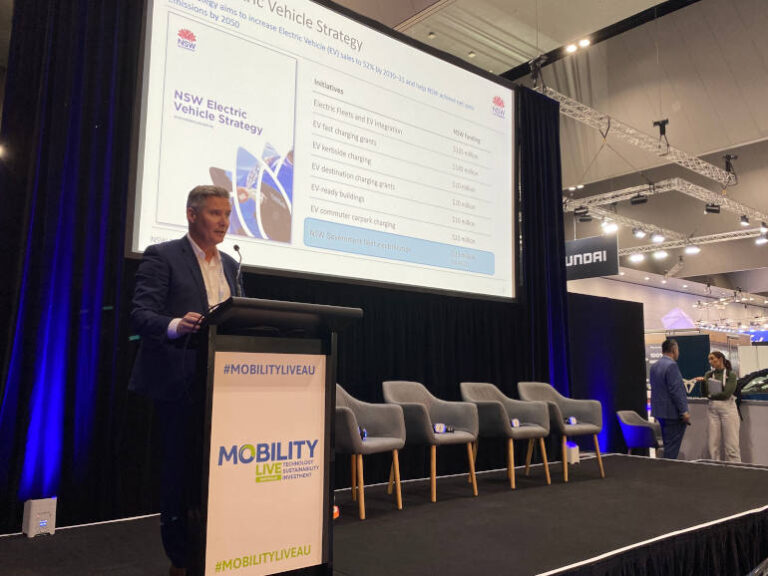At the 2024 Mobility LIVE event in Melbourne, Michael Wilson, Program Director for NSW Government Fleet Electrification at NSW Treasury, delivered an insightful presentation. It’s the first time Fleet News Group has seen any detail on the initial phase of New South Wales’ ambitious plan to convert its 20,000-vehicle government fleet to electric vehicles (EVs). It felt like a significant moment, not only because it marked Wilson’s debut delivering this presentation, but in a twist of irony, this groundbreaking plan was presented in Victoria where the state government is falling further behind in the race to decarbonisation its fleet.
Clear Targets: NSW’s EV Procurement and Charging Infrastructure Goals
At the heart of NSW’s fleet electrification strategy are two primary objectives. By 2030, the government aims for 100% of its passenger vehicle purchases to be EVs, with an interim target of 50% by 2026. These targets are supported by a detailed roadmap and policy framework designed to ease the transition for government agencies, ensuring all passenger vehicle procurements follow an “EV-first” policy. If an EV is not selected, an executive approval is required, adding a layer of accountability.
Charging infrastructure also forms a crucial part of the program, with a pilot phase focused on electrifying 240 sites. The government envisions a one-to-one charger-to-vehicle ratio to streamline charging accessibility. The 2025-26 financial year is expected to be a pivotal point in this journey, as EV adoption across NSW government agencies accelerates due to both infrastructure readiness and procurement targets.
Roadmap to Success: Data-Driven and Phased Approach
To ensure feasibility, Wilson highlighted how the NSW Treasury collaborated with agencies, using data modeling to create an optimised, operationally viable pathway to reach the EV procurement targets. The roadmap showcases a gradual increase in EV procurement, with a significant ramp-up projected in the 2025-26 financial year. This phased approach aligns with the strategy of prioritising infrastructure readiness, so the transition can proceed without bottlenecks.
Additionally, funding support has been allocated to bridge the Total Cost of Ownership (TCO) gap between EVs and internal combustion engine vehicles so the individual departments are bearing any additional costs.
Targeting 12,000 Vehicles First, While Preparing for More
Wilson outlined the vast scope of the project, noting that NSW’s government fleet spans 20,000 vehicles, including passenger vehicles, light and heavy commercials, excluding specialised vehicles such as emergency services and police. For now, the program prioritises 12,000 passenger vehicles, considered the “low-hanging fruit” due to their compatibility with available EV models and market supply. More challenging categories, like heavy and light commercial vehicles, will be considered in future phases as technology and supply evolve.
Change Management: The Key to Program Success
The presentation provided insights into the change management strategies integral to the program’s progress. Early on, the team recognised that fleet electrification is as much a change management challenge as it is a logistical one. NSW Treasury established comprehensive policies and guidelines, supported by an extensive roadmap, to help agencies transition smoothly. They also implemented initiatives such as “EV Days” and “try-before-you-buy” schemes, where fleet managers and drivers can experience EVs firsthand, proving invaluable in overcoming resistance and fostering buy-in.
Collaborative Approach to Charging Infrastructure
Wilson emphasised the collaborative approach taken in setting up charging infrastructure. Recognising that some agencies are more adept at managing infrastructure rollout than others, the program leverages resources from central government partners like Property NSW, which manages a significant number of government-leased sites. This collaborative model ensures a consistent and efficient infrastructure rollout, even in regional areas.
Split Hardware, Unified Software: A Holistic View of Charging Behaviour
In a strategic move to manage charging data and optimise network efficiency, NSW Treasury has implemented a split approach for EV charging infrastructure. While hardware procurement allows for flexibility with multiple suppliers, all charging stations across government sites are mandated to use a single software solution provided by Chargefox. This unified software platform offers NSW agencies a consistent, holistic view of charging behaviour, with insights into usage, costs, and CO2 abatement. The software integration not only enhances visibility but also enables fleet managers to make informed decisions regarding fleet utilisation and future infrastructure requirements.
Strong Policies for Accountability and Compliance
A recurring theme in Wilson’s presentation was the importance of strong policy settings to guide and measure progress. NSW has adopted an “EV-first” procurement policy across government departments, ensuring that electric options are prioritised whenever possible. Wilson stressed that this policy isn’t a mere suggestion but a governance mechanism with compliance monitoring and escalation channels. It aligns with NSW’s commitment to evidence-based, equitable implementation, particularly focusing on business areas with suitable operational requirements.
Looking Ahead: Updating the Roadmap for 2025-2031
As the pilot phase nears completion, NSW Treasury is already working on the next phase of the roadmap, planned for 2025-26 through to 2031. The updated roadmap will incorporate the latest market data, fleet usage patterns from telematics, and evolving technology trends. Wilson emphasised that this refresh aims to adapt to changing circumstances, ensuring the program remains relevant and effective.
Key Takeaways from the Pilot Phase
Wilson closed his presentation with a series of key takeaways:
- Collaboration is Essential – Especially in managing charging infrastructure across various agencies with differing capabilities.
- Top-to-Bottom Change Management – Ensuring buy-in from senior executives down to individual drivers.
- Robust Policy Settings – Including the EV-first policy, backed by governance structures monitoring compliance.
- Target Low-Hanging Fruit – Identify business areas and sites where EV adoption is most feasible and scale from there.
A Call to Action
The presentation resonated deeply with the audience which acknowledged the absence of Victorian Government representatives to discuss their own fleet emission reduction plans. This gap highlighted a stark contrast between NSW’s proactive strategy and the seeming lack of urgency from Victoria.






